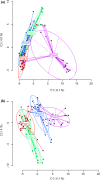Epigenetic variation associated with responses to different habitats in the context of genetic divergence in Phragmites australis
- PMID: 34522347
- PMCID: PMC8427615
- DOI: 10.1002/ece3.7954
Epigenetic variation associated with responses to different habitats in the context of genetic divergence in Phragmites australis
Abstract
The mechanisms underlying heritable phenotypic divergence associated with adaptation in response to environmental stresses may involve both genetic and epigenetic variations. Several prior studies have revealed even higher levels of epigenetic variation than genetic variation. However, few population-level studies have explored the effects of epigenetic variation on species with high levels of genetic diversity distributed across different habitats. Using AFLP and methylation-sensitive AFLP markers, we tested the hypothesis that epigenetic variation may contribute to differences in plants occupying different habitats when genetic variation alone cannot fully explain adaptation. As a cosmopolitan invasive species, Phragmites australis (common reed) together with high genetic diversity and remarkable adaptability has been suggested as a model for responses to global change and indicators of environmental fluctuations. We found high levels of genetic and epigenetic diversity and significant genetic/epigenetic structure within each of 12 studied populations sampled from four natural habitats of P. australis. Possible adaptive epigenetic variation was suggested by significant correlations between DNA methylation-based epigenetic differentiation and adaptive genetic divergence in populations across the habitats. Meanwhile, various AMOVAs indicated that some epigenetic differences may respond to various local habitats. A partial Mantel test was used to tease out the correlations between genetic/epigenetic variation and habitat after controlling for the correlation between genetic and epigenetic variations. We found that epigenetic diversity was affected mostly by soil nutrient availability, suggesting that at least some epigenetic differentiation occurred independently of genetic variation. We also found stronger correlations between epigenetic variation and phenotypic traits than between genetic variation and such traits. Overall, our findings indicate that genetically based differentiation correlates with heterogeneous habitats, while epigenetic variation plays an important role in ecological differentiation in natural populations of P. australis. In addition, our results suggest that when assessing global change responses of plant species, intraspecific variation needs to be considered.
Keywords: DNA methylation; cosmopolitan species; epigenetic differentiation; habitats; partial Mantel.
© 2021 The Authors. Ecology and Evolution published by John Wiley & Sons Ltd.
Conflict of interest statement
The authors have no conflict of interest to declare.
Figures



References
-
- Anderson, M. J. (2003). DISTLM forward: A Fortran computer program to calculate a distance‐based multivariate analysis for a linear model using forward selection. Department of Statistics, University of Auckland.
-
- Anderson, M. J. (2003). PCO: A FORTRAN Computer Program for Principal Coordinate Analysis. Department of Statistics, University of Auckland.
Associated data
LinkOut - more resources
Full Text Sources
Research Materials

